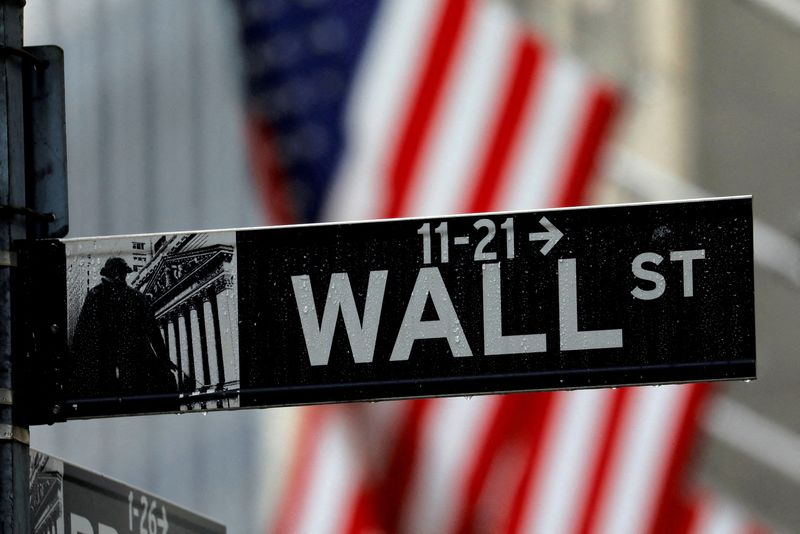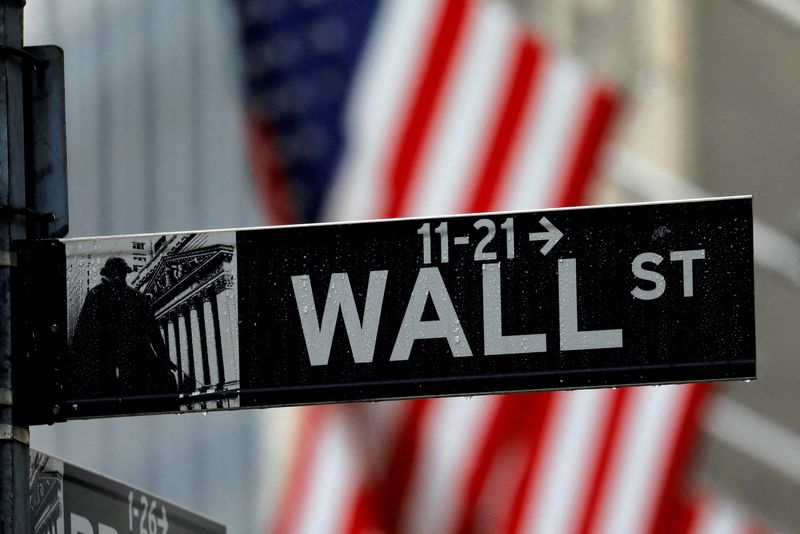Economy
US bank regulators announce sweeping proposals on capital rules


© Reuters. FILE PHOTO: Raindrops hang on a sign for Wall Street outside the New York Stock Exchange in Manhattan in New York City, New York, U.S., October 26, 2020. REUTERS/Mike Segar/File Photo
WASHINGTON (Reuters) – U.S. regulators unveiled a sweeping overhaul Thursday that would direct banks to set aside billions more in capital to guard against risk.
If fully implemented, the proposal would raise capital requirements for large banks by an aggregate 16% from current levels, with the brunt felt by the largest and most complex firms, regulators said. Here are key quotes about the proposal:
FINANCIAL SERVICES FORUM CEO KEVIN FROMER
“There is no justification for significant increases in capital at the largest U.S. banks.”
“Regulators and other policymakers should carefully consider the harmful economic impact of this proposal along with the demonstrated strength of the banking industry, the competitive advantage it may provide large European banks, and the movement of banking services into the non-bank sector.”
RICK MECKLER, PARTNER, CHERRY LANE INVESTMENTS IN NEW VERNON, NEW JERSEY
“This is a very long process and any instant reaction to it is probably misplaced.”
“This is probably close to the worst case of what it could be. But there’s going to be a long period of negotiation and politics before implementation … It’s somewhere between two and four years away.”
MAYRA RODRIGUEZ VALLADARES, MANAGING PRINCIPAL OF MRV ASSOCIATES
“Unfortunately, they do not go far enough in order to measure operational risk, market risk, and even to a certain extent credit risk.”
“Big banks are still allowed to use very complex models that only a minority of people really understand. And so there’s still a lot of flexibility for banks to understate their level of risk, especially in the area of operational risks,” she said.
SECURITIES INDUSTRY AND FINANCIAL MARKETS ASSOCIATION CEO KENNETH BENTSEN
“Regulators have failed to provide justification for such an increase in capital requirements for the trading book, particularly given how resilient U.S. markets have been since the Global Financial Crisis.
“Imposing a punitive capital charge on businesses that provide steady fee income is misguided.”
BANK OF AMERICA CEO BRIAN MOYNIHAN, ON FOX BUSINESS
The process needs to assure “the playing field is level,” and rules should be implemented carefully so they do not “make the U.S. less competitive.”
ANDY DUANE, ATTORNEY AT POLUNSKY BEITEL GREEN”Raising capital requirements could see regional banks shift away from mortgage lending. Even larger bank lenders could continue to retreat from mortgage lending or impose sharp increase in fees passed along to borrowers.”
“With potential borrowers already facing record high interest rates, steep home prices, and supply-chain issues; increased fees and scarcity of bank lenders could be another brick in the wall stopping Americans from obtaining meaningful homeownership and wealth creation.”
BANK POLICY INSTITUTE CEO GREG BAER “Today’s proposal would unnecessarily increase the amount of required capital for banks, with resulting harm for consumers and small businesses and a continued migration of financial activity into unregulated parts of the financial sector.”
“The dramatic capital increases proposed today reflect a bad deal cut in Basel without public transparency or Congressional input, with an addition of unnecessary layers of capital solely for banks operating in the United States. A proposal of this magnitude requires a robust and thorough economic analysis, which this one lacks.”
Economy
Russian central bank says it needs months to make sure CPI falling before rate cuts -RBC


© Reuters. Russian Central Bank Governor Elvira Nabiullina attends a news conference in Moscow, Russia June 14, 2019. REUTERS/Shamil Zhumatov/File Photo
MOSCOW (Reuters) – Russia’s central bank will need two to three months to make sure that inflation is steadily declining before taking any decision on interest rate cuts, the bank’s governor Elvira Nabiullina told RBC media on Sunday.
The central bank raised its key interest rate by 100 basis points to 16% earlier in December, hiking for the fifth consecutive meeting in response to stubborn inflation, and suggested that its tightening cycle was nearly over.
Nabiullina said it was not yet clear when exactly the regulator would start cutting rates, however.
“We really need to make sure that inflation is steadily decreasing, that these are not one-off factors that can affect the rate of price growth in a particular month,” she said.
Nabiullina said the bank was taking into account a wide range of indicators but primarily those that “characterize the stability of inflation”.
“This will take two or three months or more – it depends on how much the wide range of indicators that characterize sustainable inflation declines,” she said.
The bank will next convene to set its benchmark rate on Feb. 16.
The governor also said the bank should have started monetary policy tightening earlier than in July, when it embarked on the rate-hiking cycle.
Economy
China identifies second set of projects in $140 billion spending plan


© Reuters. FILE PHOTO: Workers walk past an under-construction area with completed office towers in the background, in Shenzhen’s Qianhai new district, Guangdong province, China August 25, 2023. REUTERS/David Kirton/File Photo
SHANGHAI (Reuters) – China’s top planning body said on Saturday it had identified a second batch of public investment projects, including flood control and disaster relief programmes, under a bond issuance and investment plan announced in October to boost the economy.
With the latest tranche, China has now earmarked more than 800 billion yuan of its 1 trillion yuan ($140 billion) in additional government bond issuance in the fourth quarter, as it focuses on fiscal steps to shore up the flagging economy.
The National Development and Reform Commission (NDRC) said in a statement on Saturday it had identified 9,600 projects with planned investment of more than 560 billion yuan.
China’s economy, the world’s second largest, is struggling to regain its footing post-COVID-19 as policymakers grapple with tepid consumer demand, weak exports, falling foreign investment and a deepening real estate crisis.
The 1 trillion yuan in additional bond issuance will widen China’s 2023 budget deficit ratio to around 3.8 percent from 3 percent, the state-run Xinhua news agency has said.
“Construction of the projects will improve China’s flood control system, emergency response mechanism and disaster relief capabilities, and better protect people’s lives and property, so it is very significant,” the NDRC said.
The agency said it will coordinate with other government bodies to make sure that funds are allocated speedily for investment and that high standards of quality are maintained in project construction.
($1 = 7.1315 renminbi)
Economy
Russian central bank says it needs months to make sure CPI falling before rate cuts -RBC


© Reuters. Russian Central Bank Governor Elvira Nabiullina attends a news conference in Moscow, Russia June 14, 2019. REUTERS/Shamil Zhumatov/File Photo
MOSCOW (Reuters) – Russia’s central bank will need two to three months to make sure that inflation is steadily declining before taking any decision on interest rate cuts, the bank’s governor Elvira Nabiullina told RBC media on Sunday.
The central bank raised its key interest rate by 100 basis points to 16% earlier in December, hiking for the fifth consecutive meeting in response to stubborn inflation, and suggested that its tightening cycle was nearly over.
Nabiullina said it was not yet clear when exactly the regulator would start cutting rates, however.
“We really need to make sure that inflation is steadily decreasing, that these are not one-off factors that can affect the rate of price growth in a particular month,” she said.
Nabiullina said the bank was taking into account a wide range of indicators but primarily those that “characterize the stability of inflation”.
“This will take two or three months or more – it depends on how much the wide range of indicators that characterize sustainable inflation declines,” she said.
The bank will next convene to set its benchmark rate on Feb. 16.
The governor also said the bank should have started monetary policy tightening earlier than in July, when it embarked on the rate-hiking cycle.

 Forex2 years ago
Forex2 years agoForex Today: the dollar is gaining strength amid gloomy sentiment at the start of the Fed’s week

 Forex2 years ago
Forex2 years agoHow is the Australian dollar doing today?

 Forex1 year ago
Forex1 year agoUnbiased review of Pocket Option broker

 Forex2 years ago
Forex2 years agoDollar to pound sterling exchange rate today: Pound plummeted to its lowest since 1985

 Cryptocurrency2 years ago
Cryptocurrency2 years agoWhat happened in the crypto market – current events today

 World2 years ago
World2 years agoWhy are modern video games an art form?

 Stock Markets2 years ago
Stock Markets2 years agoMorgan Stanley: bear market rally to continue

 Economy2 years ago
Economy2 years agoCrude oil tankers double in price due to EU anti-Russian sanctions

































